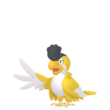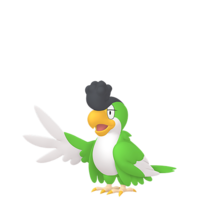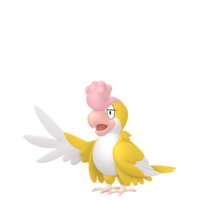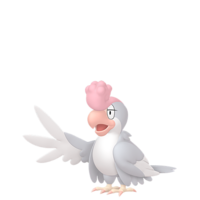|
|
| Line 105: |
Line 105: |
|
| |
|
| ====Minor appearances==== | | ====Minor appearances==== |
| The Green Plumage and Blue Plumage forms of Squawkabilly made their debut in [[HZ015]], as part of the [[Paldea]] [[Flying Taxi]] flock. The flock consisted of two of each form of Squawkabilly, except White Plumage. | | The Green Plumage and Blue Plumage forms of Squawkabilly made their debut in ''[[HZ015|Someone We Can't See! Whosawhatsit?!]]'', as part of the [[Paldea]] [[Flying Taxi]] flock. The flock consisted of two of each form of Squawkabilly, except White Plumage. |
|
| |
|
| ===Pokémon: Paldean Winds=== | | ===Pokémon: Paldean Winds=== |
Squawkabilly (Japanese: イキリンコ Ikirinko) is a dual-type Normal/Flying Pokémon introduced in Generation IX.
While it is not known to evolve into or from any other Pokémon, Squawkabilly has four separate forms: Green Plumage, Blue Plumage, Yellow Plumage, and White Plumage.
Biology
Squawkabilly is an avian Pokémon resembling a parrot, with a large rounded yellow beak and lazy eyes. It has tan legs with feet shaped in a zygodactyl arrangement; i.e. two toes each on the front and back. Each toe is tipped with a yellow claw. Squawkabilly has a rounded, lumpy black crest on its head that resembles a pompadour, and white feathers on its eyelids, face, belly, and the tips of its wings. The rest of its feathers have different colorations depending on the form, which come in green, blue, yellow, and off-white. The feathers around the bottom of its body are notably longer, giving the appearance of a longcoat.
Squawkabilly are known to be exceptionally noisy. They have a strong sense of community and dislike being alone, so they cooperate and form flocks that can contain more than 50 individuals based on the color of their feathers. In the mornings and evenings, they search for food in forests, towns, and cities; the latter is their preferred habitat, where they fight with other Squawkabilly of different plumes over territory. Green Plumage Squawkabilly make up the largest, most powerful groups, and are viewed by their Blue Plumage counterparts as rivals. Yellow Plumage Squawkabilly are especially fierce, engaging in vicious close combat and driving other bird Pokémon out of towns. White Plumage Squawkabilly have the fewest population numbers, although they are still able to hold territory because their feathers help them camouflage against the white buildings of cities. Squawkabilly once had violent territorial disputes with Fletchling, who inhabit the same rural and urban areas.
In Paldea, Squawkabilly is used for the region's Flying Taxi service. Certain Squawkabilly, such as the one found in Medali in the core series games, and Lucca's in the anime, are shown to be capable of mimicking human speech.
Forms
Squawkabilly has four separate forms: Green Plumage, Blue Plumage, Yellow Plumage, and White Plumage.
| Green Plumage
|

|
|
| Blue Plumage
|

|
|
| Yellow Plumage
|
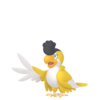
|
|
| White Plumage
|
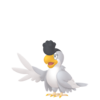
|
|
In the anime
Main series
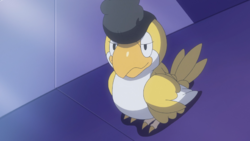
A Yellow Plumage Squawkabilly in the
animeMajor appearances
Yellow Plumage Squawkabilly debuted in The Future I Choose!, alongside Lucca. It was later revealed to actually be under the ownership of Liko's grandmother, Diana. It has since made further appearances in Pokémon Horizons: The Series.
Minor appearances
The Green Plumage and Blue Plumage forms of Squawkabilly made their debut in Someone We Can't See! Whosawhatsit?!, as part of the Paldea Flying Taxi flock. The flock consisted of two of each form of Squawkabilly, except White Plumage.
Pokémon: Paldean Winds
A Green Plumage Squawkabilly appeared in Take a Breath.
In the manga
In the TCG
- Main article: Squawkabilly (TCG)
Game data
NPC appearances
Pokédex entries
| This Pokémon was unavailable prior to Generation IX.
|
| Generation IX
|
|
Paldea
#113
|
|
Kitakami
#—
|
|
Blueberry
#—
|
| Green Plumage
|
| Scarlet
|
These Pokémon prefer to live in cities. They form flocks based on the color of their feathers, and they fight over territory.
|
| Violet
|
Green-feathered flocks hold the most sway. When they're out searching for food in the mornings and evenings, it gets very noisy.
|
| Blue Plumage
|
| Scarlet
|
The largest of their flocks can contain more than 50 individuals. They fly around towns and forests, searching for food and making a racket.
|
| Violet
|
Blue-feathered Squawkabilly view their green-feathered counterparts as rivals, since the latter make up the largest, most powerful groups.
|
| Yellow Plumage
|
| Scarlet
|
These Squawkabilly are hotheaded, and their fighting style is vicious. They’ll leap within reach of their foes to engage in close combat.
|
| Violet
|
The yellow Squawkabilly are especially fierce. They've even been known to drive other bird Pokémon out of town.
|
| White Plumage
|
| Scarlet
|
This Pokémon dislikes being alone. It has a strong sense of community and survives by cooperating with allies.
|
| Violet
|
Though these Squawkabilly are the fewest in number, they have no trouble living in towns since they blend in with the white buildings.
|
|
|
Game locations
| This Pokémon was unavailable prior to Generation IX.
|
|
|
In side games
Held items
Stats
Base stats
| Stat
|
Range
|
| At Lv. 50
|
At Lv. 100
|
82
|
|
142 - 189
|
274 - 368
|
96
|
|
90 - 162
|
177 - 320
|
51
|
|
50 - 113
|
96 - 221
|
45
|
|
45 - 106
|
85 - 207
|
51
|
|
50 - 113
|
96 - 221
|
92
|
|
87 - 158
|
170 - 311
|
Total: 417
|
Other Pokémon with this total
|
- Minimum stats are calculated with 0 EVs, IVs of 0, and (if applicable) a hindering nature.
- Maximum stats are calculated with 252 EVs, IVs of 31, and (if applicable) a helpful nature.
|
Type effectiveness
| Under normal battle conditions in Generation IX, this Pokémon is:
|
|
|
|
|
|
|
|
|
|
|
|
|
Learnset
|
|
|
|
- Bold indicates a move that gets STAB when used by Squawkabilly
- Italic indicates a move that gets STAB only when used by an Evolution of Squawkabilly
|
|
|
|
|
- Bold indicates a move that gets STAB when used by Squawkabilly
- Italic indicates a move that gets STAB only when used by an Evolution or an alternate form of Squawkabilly
|
|
|
|
|
- Moves marked with an asterisk (*) must be chain bred onto Squawkabilly
- Bold indicates a move that gets STAB when used by Squawkabilly
- Italic indicates a move that gets STAB only when used by an Evolution of Squawkabilly
|
Side game data
Form data
Squawkabilly has four different non-interchangeable forms, each with differently colored plumage. The only functional difference between the forms is their Hidden Abilities, with the Green Plumage and Blue Plumage forms having Guts and the Yellow Plumage and White Plumage forms having Sheer Force.
Evolution data
Green Plumage
Blue Plumage
Yellow Plumage
White Plumage
Sprites
| This Pokémon was unavailable prior to Generation IX.
|
|
|
Trivia
Origin
Squawkabilly seems to be based on a parakeet or a small parrot. It may in particular be inspired by the monk parakeet, an invasive species that forms large flocks in Spain and can have green, blue, yellow, or white plumages, with green being the most common. Given its crest, it may also be loosely based on a cockatoo (mainly a red-tailed black cockatoo).
Squawkabilly's appearance and behavior may be based on punk or delinquent archetypes: the crest above its head resembles a pompadour hairstyle common to the type, and its behavior of flocking together based on plumage colors and being hostile to those of differently colored plumage may represent street gangs and gang violence. Its pompadour hairstyle and noisy behavior could also be inspired by the rocker subculture.
Name origin
Squawkabilly may be a combination of squawk, bill (beak), and rockabilly.
Ikirinko may be a combination of イキり ikiri (slang for a cocky person) and 鸚哥 inko (parrot).
In other languages
| Language
|
Title
|
Meaning
|
 Japanese Japanese
|
イキリンコ Ikirinko
|
From イキり ikiri and 鸚哥 inko
|
 French French
|
Tapatoès
|
From tapage and cacatoès
|
 Spanish Spanish
|
Squawkabilly
|
Same as English name
|
 German German
|
Krawalloro
|
From Krawall and loro
|
 Italian Italian
|
Squawkabilly
|
Same as English name
|
 Korean Korean
|
시비꼬 Sibikko
|
From 시비 (是非) sibi and 잉꼬 ingkko
|
 Mandarin Chinese Mandarin Chinese
|
怒鸚哥 / 怒鹦哥 Nùyīnggē
|
From 怒 nù and 鸚哥 / 鹦哥 yīnggē
|
 Cantonese Chinese Cantonese Chinese
|
怒鸚哥 Nouhyīnggō
|
From 怒 nouh and 鸚哥 yīnggō
|
|
|
|
| More languages
|
 Hindi Hindi
|
मियांमिठू Miyāmmiṭhū
|
From मियां मिट्ठू miyaan mitthoo
|
 Thai Thai
|
อิคิริงโกะ Ikhiringko
|
Transcription of Japanese name
|
|
|
|
Related articles
External links

|
This Pokémon article is part of Project Pokédex, a Bulbapedia project that aims to write comprehensive articles on each Pokémon species, as well as Pokémon groups and forms.
|

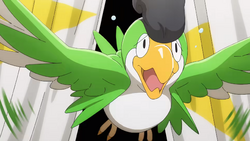





 For other sprites and images, please see Squawkabilly images on the Bulbagarden Archives.
For other sprites and images, please see Squawkabilly images on the Bulbagarden Archives.


